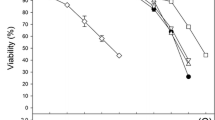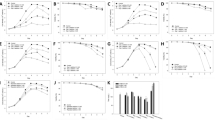Abstract
Sodium butyrate is commonly used in mammalian cell cultures to increase the productivity of recombinant proteins. A Chinese hamster ovary (CHO) cell line producing recombinant human erythropoietin (rhEPO) was cultured in commercial medium. Addition of 0.5 mM butyrate inhibited the over-growth of the cells after the medium was changed from serum-added medium to serum-free medium. At the 6th day, the addition of butyrate lowered the transcriptional level of sialidases I, II, and III compared to that of control groups by 56, 87, and 59 %, respectively. Extracellular sialidase activity was decreased by 53 % by addition of butyrate. The inhibition of cell over-growth and the decrease of extracellular sialidase activity helped to increase the acidic isoform content of rhEPO expressed by this CHO cell strain.





Similar content being viewed by others
References
Berger M, Kaup M, Blanchard V (2012) Protein glycosylation and its impact on biotechnology. In: Hu WS, Zeng AP (eds) Genomics and systems biology of mammalian cell culture, Advances in biochemical engineering/biotechnology, vol 127. Springer Science and Business Media, Germany, pp 165–185
Chuan KH, Lim SF, Martin L, Yun CY, Loh SO, Lasne F, Song Z (2006) Caspase activation, sialidase release and changes in sialylation pattern of recombinant human erythropoietin produced by CHO cells in batch and fed-batch cultures. Cytotechnology 51:67–79
Crowell CK, Qin Q, Grampp GE, Radcliffe RA, Rogers GN, Scheinman RI (2008) Sodium butyrate alters erythropoietin glycosylation via multiple mechanisms. Biotechnol Bioeng 99:201–213
Dietmair S, Hodson MP, Quek L, Timmins NE, Chrysanthopoulos P, Jacob SS, Gray P, Nielsen LK (2012) Metabolite profiling of CHO cells with different growth characteristics. Biotechnol Bioeng 109:1404–1414
Gramer MJ, Goochee CF, Chock VY, Brousseau DT, Sliwkowski MB (1995) Removal of sialic acid from a glycoprotein in CHO cell culture supernatant by action of an extracellular CHO cell sialidase. Nat Biotechnol 13:692–698
Kim JY, Kim Y, Lee GM (2011) CHO cells in biotechnology for production of recombinant proteins: current state and further potential. Appl Microbiol Biotechnol 93:917–930
Lamotte D, Buckberry L, Monaco L, Soria M, Jenkins N, Engasser JM, Marc A (1999) Na-butyrate increases the production and α2, 6-sialylation of recombinant interferon-γ expressed by α2,6-sialyltransferanse engineered CHO cells. Cytotechnology 29:55–64
Lim SF, Lee MM, Zhang P, Song Z (2008) The Golgi CMP-sialic acid transporter: a new CHO mutant provides functional insights. Glycobiology 18:851–860
McMurray-Beaulieu V, Hisiger S, Durand C, Perrier M, Jolicoeur M (2009) Na-butyrate sustains energetic states of metabolism and t-PA productivity of CHO cells. J Biosci Bioeng 108:160–167
Mimura Y, Lund J, Church S, Dong S, Li J, Goodall M, Jefferis R (2001) Butyrate increases production of human chimeric IgG in CHO-K1 cells whilst maintaining function and glycoform profile. J Immunol Methods 247:205–216
Santell L, Ryll T, Etcheverry T, Santoris M, Dutina G, Wang A, Gunson J, Warner TG (1999) Aberrant metabolic sialylation of recombinant proteins expressed in Chinese hamster ovary cells in high productivity cultures. Biochem Biophys Res Commun 258:132–137
Sup CB, Jeong YT, Chang KH, Kim JS, Kim JH (2001) Effect of sodium butyrate on glycosylation of recombinant erythropoietin. J Microbiol Biotechnol 11:1087–1092
Towbin H (2009) Blotting from immobilized pH gradient gels: application to total cell lysates. In: Kurien BT, Scofield RH (eds) Methods in molecular biology, protein blotting and detection. Humana Press, USA, pp 253–258
Verardo ML, Carvalho JG, Delgado DN, Kuhns ST (2012) Accuracy and sensitivity of residual DNA detection by QPCR is not predicted by target copy number. Biotechnol Prog 28:428–434
Zhang M, Koskie K, Ross JS, Kayser KJ, Caple MV (2010) Enhancing glycoprotein sialylation by targeted gene silencing in mammalian cells. Biotechnol Bioeng 105:1094–1105
Acknowledgments
This work was supported by National Special Project of Key Technology of China (2009ZX09503-013) and Shanghai Leading Academic Discipline Project (B505). The authors thank Mr. John Goh for critically reviewing the manuscript.
Author information
Authors and Affiliations
Corresponding authors
Rights and permissions
About this article
Cite this article
Liu, Y., Zhou, X., Song, Z. et al. Sodium butyrate enhances the acidic isoform content of recombinant human erythropoietin produced by Chinese hamster ovary cells. Biotechnol Lett 36, 907–911 (2014). https://doi.org/10.1007/s10529-013-1442-9
Received:
Accepted:
Published:
Issue Date:
DOI: https://doi.org/10.1007/s10529-013-1442-9




